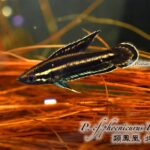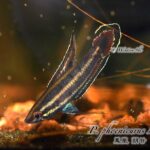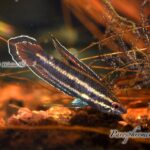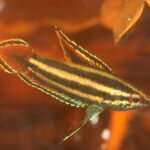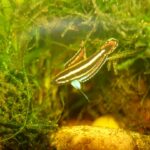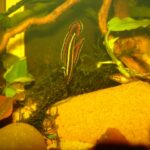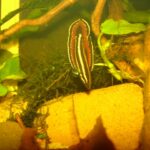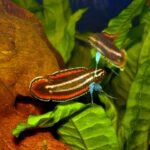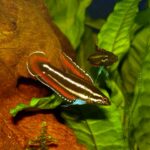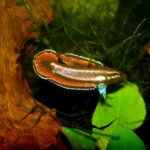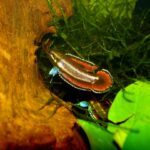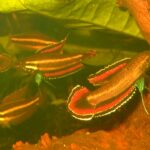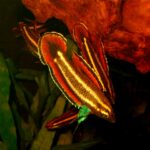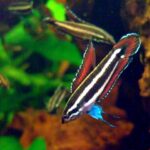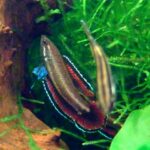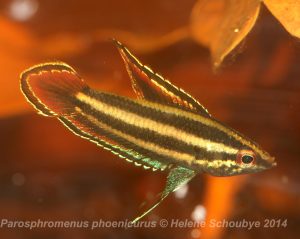
Schindler & Linke 2012
First description: Ingo Schindler/Horst Linke,Two new species of the genus Parosphromenus (Teleostei: Osphronemidae) from Sumatra. Vertebrate Zoology 62(3), 2012, p. 399-406.
Characteristics: Licorice gouramy of the bintan-harveyi-type with slightly deviating caudal. The caudal is the most striking difference to P. tweediei. Total length max. 2.90 cm (wild caught specimen), 4.0 cm (aquarium specimen). Fin formula: dorsal XI-XIII, 6-7, total 17-20, anal XI-XIII, 8-11, total 21-24. The original description puts the colouration like this: “Dorsal and anal fin with blackish band at fin base, followed by vivid red or crimson band, narrow iridescent light bluish band (more turquoise anteriorly), subdistal black band, and light blue margin. Caudal fin with almost triangular dark black patch, surrounded by vivid red or crimson band, light bluish band, subdistal black band, and light blue margin. Pelvid fin iridescent bluish-turquoise, filament black. Pectoral fin hyaline.” (Schindler/Linke).
Whereas the wild caught specimen exhibited marked colour differences to the most similar of the other species, P. tweediei, by showing less red parts, small whitish-bluish bands separating the red parts in the dorsal and caudal from the blackish bands and a marked rhombic form of the caudal, the aquarium offspring soon became more similar to tweediei, lost partially the whitish-bluish separating bands mentioned, developed much more red in all fins and in some individuals a less rhombic caudal (compare photos of the wild caught form by Linke and photos of the aquarium bred offspring by Fischer: they look like belonging to different species). The Females are again very similar to other females of that type.
Similar species: P. tweediei.A nearly constant difference is the rhombic from of the caudal (as opposed to a rounded caudal) and the nearly triangular form of its inner black spot. As mentioned, the rhombic form tends to get less marked in aquarium bred fish. Even the black spot is less marked in many males which show much more red.
In P. tweediei we have known very marked colour deviations. At some places and times the attractive red is nearly missing and substituted by bluish or greenish colours. We know nothing similar with P. phoenicurus, but this species is known from one single place only.
Ocurrence/Distribution:The only known place of origin is a blackwater swamp area near to Kota Kerincikiri, Sumatra Riau, at Langgam. This is part of a “Sungai Kampar river drainage at Langgam (about 40 km south-east of Pekanbaru), provice of Riau in the centre of Sumatra, Indonesia.” (Schindler/Linke).
Water parameters measured by Linke 2008: 26.8 degrees Celsius, a pH value of 5.25, and an electrical conductivity of 7 Microsiemens/cm
Threat: Extremely high since the species is known from that single territory only. So far, it has only been imported once privately by its discoverer. The first animals could be propagated comparatively easy, and soon there were good aquarium stocks. Meanwhile the propagation has become more difficult, but there are nevertheless several small breeding stocks.
Discovery/first import: 2008 Horst Linke discovered several putative new species of Parosphromenus from Sumatra and near islands. Among them was this new species and P. gunawani. From 2008 to 2012 P. phoenicurus was called spec. Langgam.- It is very likely that the species has never been imported by aquarists or ichthyologists before and hitherto.
Trade: In Summer 2014 a commercial Import was announced by Aquarium Dietzenbach, Germany of about 500 animals, (Locality Sungai Kampar near Langgam, Sumatra).
Care/Breeding: The species does not deviate in its requirements from other cogeners. The very low conductivity in its home habitat indicates that one should obey this feature in the aquarium, too.
Behaviour/Particularities: P. phoenicurus is one of our most attractive species of licorice gouramies. In this respect it is to be rated at the same level as P. tweediei. Given its very limited distribution (as far as we know) we should at any rate try to secure our aquarium stock. Head down courtship. Similar behaviour to other related species.
Literature:
Weblinks:


